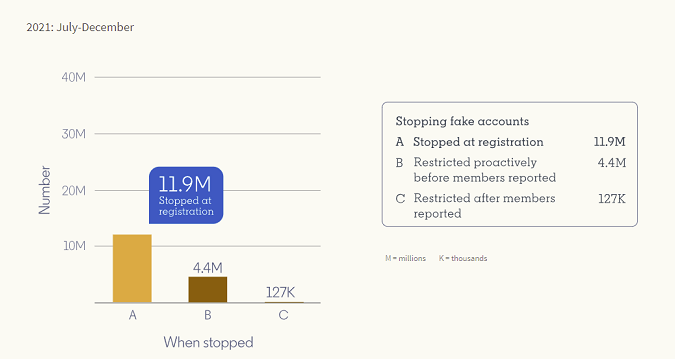SOCIAL
LinkedIn Provides New Update on Spam, Scams and Fake Profiles in the App

LinkedIn is detecting and blocking more fake accounts, thanks to improvements in its automated systems, while it also removed a lot more misinformation in the last six months of 2021, as per its latest transparency update.
LinkedIn’s Transparency Report for the second half of 2021 (July to December) provides a complete overview of actions taken on spam, misinformation, government takedown requests, and more, which provides some interesting perspective on LinkedIn’s efforts on this front.
And while LinkedIn isn’t targeted in the way that Facebook or YouTube might be on these fronts, there is still a lot of inauthentic activity in the app, with scammers looking to access information, and dupe LinkedIn users, with fake offers, connection requests, etc.
And with LinkedIn activity rising by 34% year-over-year, its main feed is also now being seen by more and more people, making it more appealing for those looking to spread false narratives.
Here’s a look at the key notes from LinkedIn’s latest transparency update.
First off, on fake accounts – LinkedIn says that its automated defenses blocked 96% of all fake accounts in the period, with 11.9 million attempts stopped in the registration process.
LinkedIn says that its improved detection technology contributed to a 19% increase in fake accounts being removed in the period prior to a member reporting them, which is category B in the chart above. That element has jumped from 3.7 million in the previous period, to 4.4 million now.
Of course, there’s no definitive way to prove that you’re catching all fake accounts. As Elon Musk is now finding on Twitter, the numbers reported are based on what each platform’s systems are able to detect, so it’s entirely possible that other false accounts are being created, and are not being detected in the same way.
That would belie some of this data – but still, based on what LinkedIn knows of, its detection systems are improving, which is a positive for real engagement and interaction in the app.
In terms of spam and scams, LinkedIn’s detection numbers have remained relatively stable versus previous reports.

LinkedIn is, however, removing more misinformation, which it says is due to ‘enhanced automated defenses that enable LinkedIn to better detect potential misinformation proactively’.

LinkedIn’s misinformation numbers have been steadily increasing over time, going from 110,742 cases dealt with in the second half of 2020, to 147,490 in the first part of 2021, to the 207k it saw in the most recent period.
Again, part of that comes down to improved detection, but with increased engagement, LinkedIn may also be seen as more of a target for such, while there’s also been a raft of divisive topics in more recent times.
On another front, Government requests for data in the app have remained steady, with the majority of requests coming from the US.

Though it is also worth noting that LinkedIn pulled its app out of China in October due to increasingly difficult compliance requirements being imposed by the CCP. That’s not reflected in these requests, but it’s another element to consider when measuring LinkedIn’s dealings with local authorities.
There are some interesting notes in LinkedIn’s transparency overview, though noting overly surprising or out of place, given outside changes and global approaches.
The bottom line is that LinkedIn’s systems are improving, though how much, exactly, it’s hard to say, because LinkedIn can’t report on what it can’t detect.
Based on what it can, it’s doing better at blocking harmful activity, but that doesn’t necessarily mean that all the LinkedIn fakes and spammers are being picked out from the heap.
You can read LinkedIn’s full Transparency Report here.
SOCIAL
Snapchat Explores New Messaging Retention Feature: A Game-Changer or Risky Move?

In a recent announcement, Snapchat revealed a groundbreaking update that challenges its traditional design ethos. The platform is experimenting with an option that allows users to defy the 24-hour auto-delete rule, a feature synonymous with Snapchat’s ephemeral messaging model.
The proposed change aims to introduce a “Never delete” option in messaging retention settings, aligning Snapchat more closely with conventional messaging apps. While this move may blur Snapchat’s distinctive selling point, Snap appears convinced of its necessity.
According to Snap, the decision stems from user feedback and a commitment to innovation based on user needs. The company aims to provide greater flexibility and control over conversations, catering to the preferences of its community.
Currently undergoing trials in select markets, the new feature empowers users to adjust retention settings on a conversation-by-conversation basis. Flexibility remains paramount, with participants able to modify settings within chats and receive in-chat notifications to ensure transparency.
Snapchat underscores that the default auto-delete feature will persist, reinforcing its design philosophy centered on ephemerality. However, with the app gaining traction as a primary messaging platform, the option offers users a means to preserve longer chat histories.
The update marks a pivotal moment for Snapchat, renowned for its disappearing message premise, especially popular among younger demographics. Retaining this focus has been pivotal to Snapchat’s identity, but the shift suggests a broader strategy aimed at diversifying its user base.
This strategy may appeal particularly to older demographics, potentially extending Snapchat’s relevance as users age. By emulating features of conventional messaging platforms, Snapchat seeks to enhance its appeal and broaden its reach.
Yet, the introduction of message retention poses questions about Snapchat’s uniqueness. While addressing user demands, the risk of diluting Snapchat’s distinctiveness looms large.
As Snapchat ventures into uncharted territory, the outcome of this experiment remains uncertain. Will message retention propel Snapchat to new heights, or will it compromise the platform’s uniqueness?
Only time will tell.
SOCIAL
Catering to specific audience boosts your business, says accountant turned coach

While it is tempting to try to appeal to a broad audience, the founder of alcohol-free coaching service Just the Tonic, Sandra Parker, believes the best thing you can do for your business is focus on your niche. Here’s how she did just that.
When running a business, reaching out to as many clients as possible can be tempting. But it also risks making your marketing “too generic,” warns Sandra Parker, the founder of Just The Tonic Coaching.
“From the very start of my business, I knew exactly who I could help and who I couldn’t,” Parker told My Biggest Lessons.
Parker struggled with alcohol dependence as a young professional. Today, her business targets high-achieving individuals who face challenges similar to those she had early in her career.
“I understand their frustrations, I understand their fears, and I understand their coping mechanisms and the stories they’re telling themselves,” Parker said. “Because of that, I’m able to market very effectively, to speak in a language that they understand, and am able to reach them.”Â
“I believe that it’s really important that you know exactly who your customer or your client is, and you target them, and you resist the temptation to make your marketing too generic to try and reach everyone,” she explained.
“If you speak specifically to your target clients, you will reach them, and I believe that’s the way that you’re going to be more successful.
Watch the video for more of Sandra Parker’s biggest lessons.
SOCIAL
Instagram Tests Live-Stream Games to Enhance Engagement

Instagram’s testing out some new options to help spice up your live-streams in the app, with some live broadcasters now able to select a game that they can play with viewers in-stream.
As you can see in these example screens, posted by Ahmed Ghanem, some creators now have the option to play either “This or That”, a question and answer prompt that you can share with your viewers, or “Trivia”, to generate more engagement within your IG live-streams.
That could be a simple way to spark more conversation and interaction, which could then lead into further engagement opportunities from your live audience.
Meta’s been exploring more ways to make live-streaming a bigger consideration for IG creators, with a view to live-streams potentially catching on with more users.
That includes the gradual expansion of its “Stars” live-stream donation program, giving more creators in more regions a means to accept donations from live-stream viewers, while back in December, Instagram also added some new options to make it easier to go live using third-party tools via desktop PCs.
Live streaming has been a major shift in China, where shopping live-streams, in particular, have led to massive opportunities for streaming platforms. They haven’t caught on in the same way in Western regions, but as TikTok and YouTube look to push live-stream adoption, there is still a chance that they will become a much bigger element in future.
Which is why IG is also trying to stay in touch, and add more ways for its creators to engage via streams. Live-stream games is another element within this, which could make this a better community-building, and potentially sales-driving option.
We’ve asked Instagram for more information on this test, and we’ll update this post if/when we hear back.
-

 PPC6 days ago
PPC6 days ago19 Best SEO Tools in 2024 (For Every Use Case)
-
SEARCHENGINES6 days ago
Daily Search Forum Recap: April 18, 2024
-
SEARCHENGINES5 days ago
Daily Search Forum Recap: April 19, 2024
-

 MARKETING6 days ago
MARKETING6 days agoEcommerce evolution: Blurring the lines between B2B and B2C
-

 WORDPRESS5 days ago
WORDPRESS5 days agoHow to Make $5000 of Passive Income Every Month in WordPress
-

 SEO6 days ago
SEO6 days ago2024 WordPress Vulnerability Report Shows Errors Sites Keep Making
-

 WORDPRESS6 days ago
WORDPRESS6 days ago10 Amazing WordPress Design Resouces – WordPress.com News
-
WORDPRESS7 days ago
[GET] The7 Website And Ecommerce Builder For WordPress
















You must be logged in to post a comment Login